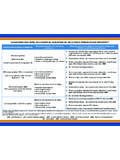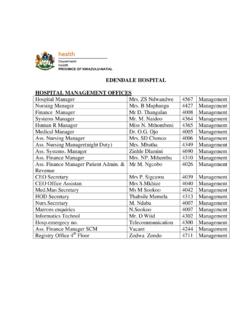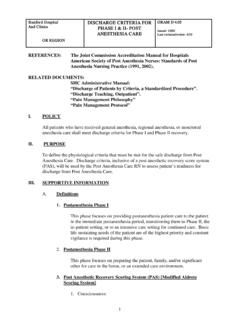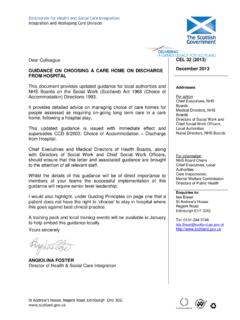Transcription of From hospitalto home - Barnardo's
1 Guidance on discharge managementand community support for childrenusing long-term ventilationJane Noyes and Mary LewishospitaltohomeFrom From hospital to HomeGuidance on discharge management and community support for children using long-term ventilationJane Noyes and Mary LewisPublished by Barnardo sTanners LaneBarkingsideIlfordEssexIG6 1 QGCharity registration number 216250 Section 2 (Exemplar) Crown copyright date 2005 All other material Barnardo s 2005 All rights reserved. No part of this publication may be reproduced, stored on an unauthorisedretrieval system, or transmitted in any form or by any means without prior permission of catalogue record for this book is available from the British 1 904659 14 4 Barnardo s vision is that the lives of all children should be freefrom poverty, abuse and purpose is to help the most vulnerable children and youngpeople transform their lives and fulfil their potential.
2 To look into some aspects of the future, we do not need projections by supercomputers. Muchof the next millennium can be seen in how we care for our children today. Tomorrow s worldmay be influenced by science and technology, but more than anything, it is already taking shapein the bodies and minds of our children Kofi Annan, Secretary General of the United Nations, UNICEF convention, ( Special case for children ) From hospital to HomeiiAcknowledgementsWe are grateful to the parents and children who have provided feedback and insights from theirperspective.
3 In particular, we would like to thank Linda Middleton (CCHS Family Support) fordistributing early drafts to parents and commenting on various drafts that helped to shape thefinal guidance draws heavily upon existing examples of best practice relating to the dischargeand ongoing management of children who require long-term ventilation. Numerous professionalshave provided us with examples of documentation currently used in clinical practice, and expertguidance. This is intended to point practitioners and professionals in the right directions, enablingthem to build their practice on foundations that are as sound as possible at this time.
4 Althoughit is not possible to acknowledge all of the individuals whose skills and expertise havecontributed to this project, there is no way that we could have completed this work withouttheir support. Many of the professionals who made a significant contribution to the developmentof this work are part of a clinical network called the UK Long-Term Ventilation Working Party,which is chaired by Dr Colin Wallis (Great Ormond Street hospital for Children NHS Trust). Inparticular, Dr Martin Samuels read and commented on various drafts (University hospital ofNorth Staffordshire).
5 In addition, members of staff who contributed include, in particular, SallyBeckley and Sarah Leggett, from the Lifetime Service, Bath, who provided valuable input to thedevelopment of the care pathway, and Jan Morrison from the Policy and Research Unit atBarnardo s who managed and supervised production of the , we are grateful to the Department of Health for commissioning this authors Jane Noyes DPhil, MSc, Cert Ed, RGN, RSCNS enior Research Fellow, School of Nursing, Midwifery and Social Work, University of Manchester Jane is an experienced researcher and children s nurse who specialises in health servicesresearch.
6 She has a special interest in the care of children with complex needs for health andsocial care, and has published widely in this area. She is a previous award holder of Smith andNephew and Medical Research Council Fellowships, which she used to move to the Universityof York and undertake an evaluation of health and social care provision for ventilator-dependentchildren in the UK. Jane currently holds a Department of Health post-doctoral fellowship and isco-convenor of the Cochrane Qualitative Research Methods Group. She has worked for theWorld Health Organisation as a consultant, contributed to national and regional working parties,and supports a number of parents Lewis MSc, RGN, RSCN, RHVS enior Nurse, The Lifetime Service, Bath and North East Somerset Primary Care Trust; andResearch Associate, Centre for Child and Adolescent Health, University of the West of EnglandMary is an experienced children s nurse who has led the development of the Lifetime Servicesince its inception 12 years ago.
7 The Lifetime Service is an innovative and unique serviceproviding children s community nursing, clinical psychology and community support to childrenwith long-term or life-threatening conditions, and their families. Mary has a specialist interest inthe care of children with complex and palliative care needs in the community. She hascontributed to a number of national working parties and collaborated on several is a trustee of the Lifetime Children s Trust, a parents group set up as part of the LifetimeService. She is seconded on a part-time basis as a Research Associate to the University of theWest of England where she is working on a number of related research and publication hospital to HomeivCopyright of documents, policies, guidelines and procedures The Department of Health supports and encourages the development of good relationships,formation of clinical networks and sharing of best practice as key principles underpinningimprovements in patient care.
8 All documents, policies, procedures and guidelines listed in thissupporting guidance or stored on the website at remain thecopyright of the original author which may be a person, NHS Trust, organisation or documents indicate otherwise, permission must be obtained from the originating authorbefore adapting any material for use any frameworks belonging to Clinovia Ltd are used or adapted in any way, this must beacknowledged on the adapted documents by inserting the following statement: adapted fromframeworks supplied with the kind permission of Clinovia Ltd.
9 DisclaimerAll documents, policies, guidelines and procedures that are referenced in this guidance and/oravailable to download from the document store on the UK Children on Long-Term Ventilation website have been provided as examples of current best practice by practitioners, NHS Trusts,private and voluntary sector organisations with experience of managing children requiring long-term ventilation. All documents have been designed for local use within a specific context. Noquality appraisal has been undertaken of any of the documentation received.
10 All documents,policies, guidelines and procedures should be adapted for local use taking into consideration: thespecific context; available research evidence; the manufacturer product licence and instructionsfor use, if appropriate; and local clinical governance and risk management am very grateful to the families, and to the many health and social care professionals who haveworked closely with Barnardo s to take forward this work on preparing for and supportingchildren requiring long term ventilation in the options for discharge must never be rushed, there is no reason why a child s movefrom hospital to home should be delayed because of a lack of familiarity with proceduralarrangements and considerations.
















